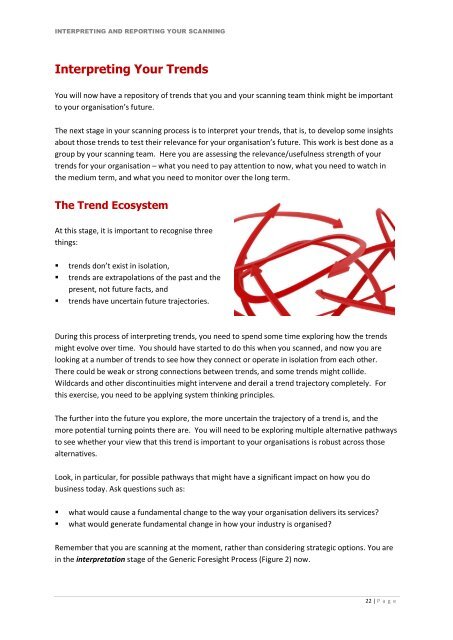Environmental Scanning - Thinking Futures
Environmental Scanning - Thinking Futures
Environmental Scanning - Thinking Futures
Create successful ePaper yourself
Turn your PDF publications into a flip-book with our unique Google optimized e-Paper software.
INTERPRETING AND REPORTING YOUR SCANNING<br />
Interpreting Your Trends<br />
You will now have a repository of trends that you and your scanning team think might be important<br />
to your organisation’s future.<br />
The next stage in your scanning process is to interpret your trends, that is, to develop some insights<br />
about those trends to test their relevance for your organisation’s future. This work is best done as a<br />
group by your scanning team. Here you are assessing the relevance/usefulness strength of your<br />
trends for your organisation – what you need to pay attention to now, what you need to watch in<br />
the medium term, and what you need to monitor over the long term.<br />
The Trend Ecosystem<br />
At this stage, it is important to recognise three<br />
things:<br />
• trends don’t exist in isolation,<br />
• trends are extrapolations of the past and the<br />
present, not future facts, and<br />
• trends have uncertain future trajectories.<br />
During this process of interpreting trends, you need to spend some time exploring how the trends<br />
might evolve over time. You should have started to do this when you scanned, and now you are<br />
looking at a number of trends to see how they connect or operate in isolation from each other.<br />
There could be weak or strong connections between trends, and some trends might collide.<br />
Wildcards and other discontinuities might intervene and derail a trend trajectory completely. For<br />
this exercise, you need to be applying system thinking principles.<br />
The further into the future you explore, the more uncertain the trajectory of a trend is, and the<br />
more potential turning points there are. You will need to be exploring multiple alternative pathways<br />
to see whether your view that this trend is important to your organisations is robust across those<br />
alternatives.<br />
Look, in particular, for possible pathways that might have a significant impact on how you do<br />
business today. Ask questions such as:<br />
• what would cause a fundamental change to the way your organisation delivers its services?<br />
• what would generate fundamental change in how your industry is organised?<br />
Remember that you are scanning at the moment, rather than considering strategic options. You are<br />
in the interpretation stage of the Generic Foresight Process (Figure 2) now.<br />
22 | P a g e



